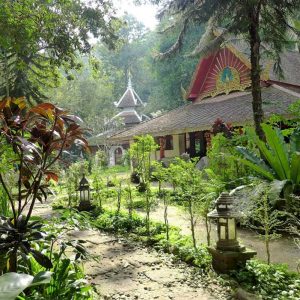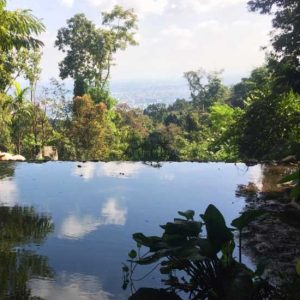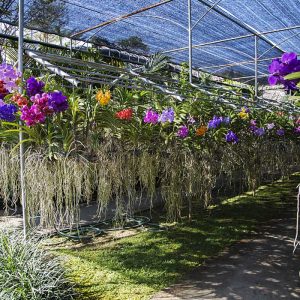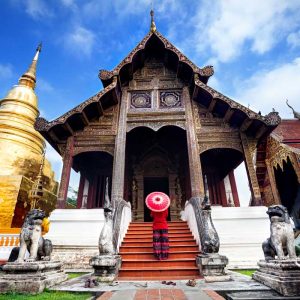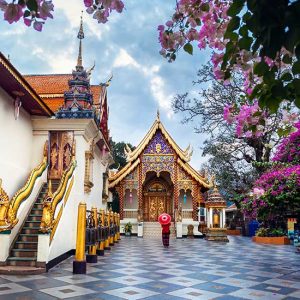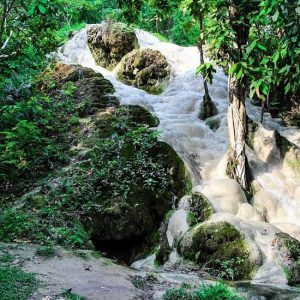Doi Suthep Tours – Doi Suthep morning Tours – Half day Doi Suthep tour – Doi Suthep evening Tours
First time visitors come to Chiang Mai are sure to take notice of the mountain which borders the western edge of the city and to wonder what fabulous places they can visit with Doi Suthep Tours.
Northern Thailand is known for its many mountain ranges and Doi Pui is the eighth highest peak in Thailand.
Chiang Mai’s famous Doi Suthep temple sits on the eastern side of this mountain and looks out over the city.
The official name is Wat Phrathat Doi Suthep and it has kept its eye on Chiang Mai for hundreds of years.
On a clear day, the temple can be seen from locations throughout the Ping valley.
Doi Suthep tours is a must see tour for visitors to Chiang Mai.
Temples are an important part of life in Thailand and the temple on Doi Suthep is almost as famous as the Temple of the Emerald Buddha in Bangkok.
One of the unique features of this Chiang Mai attraction is the over 300 step staircase which is bordered by mythical naga snakes. The climb to the top of the stairs is not an easy endeavor, but the view at the top is well worth it.
Chiang Mai Tours
Chiang Mai Tours
Doi Suthep Puping Palace tour from Chiang Mai [$19 all included – top travelers choice]
Chiang Mai Tours
Chiang Mai Tours
Doi Suthep Tours – Doi Suthep morning Tours – Half day Doi Suthep tour – Doi Suthep evening Tours
Dress Code Requirements
With Doi Suthep Tours please if you wish to enter the inner temple area, adherence to a dress code is required.
Don’t worry; there is clothing to borrow for those who may not be prepared for the strict dress code.
Temple Areas and Attractions
The large chedi in the sacred temple area is the center of many photos which represent the city of Chiang Mai. This inner area is often busy with Thai nationals making merit at several designated altars. This is usually a sight to behold on Doi Suthep day tours.
The outer courtyard has much activity as well. Tourists and Thai pilgrims alike often take pictures of the many Buddha images and the view of the city below. One of the favorite attractions in this outer courtyard is the row of bells and gongs on the outside sanctuary wall. Doi Suthep tour is a popular Chiang Mai attraction for locals and foreigners.
Tourist Facilities
Every tourist site, whether for foreign or local tourists, offers any array of small restaurants and shops selling souvenirs. The area around Doi Suthep temple is no different from other tourist areas.
There is no need to pack a lunch or even to bring drink along on your trip to the mountain. Anything you need for basic survival can be purchased on the spot.
Unlike western countries, prices for food and drink are rarely inflated in the tourist areas.
Now we can take a look more in depth about all the locations you can visit with.
Doi Suthep Temple Sightseeing
Thailand’s temples have always attracted me due to that they are unique and rich in history. As I was searching on my next trip to Thailand individually visit a temple, I came across one temple Doi Suthep.
One thing which attracted me more to this temple is that it offers one chance to experience sightseeing. This post will tell you all about Doi Suthep Temple as well as nearby temples.
Doi Suthep temple in Chiang Mai Province, Thailand, is a Theravada Buddhist temple (wat).
The temple is often referred to as “Doi Suthep,” although this is the name of the mountain in which it is situated.
For many Thai people, it is a sacred site. The temple is located at an altitude of 1,073 meters (15 kilometers (9.3 mi) from Chiang Mai City. Great views of downtown Chiang Mai can be seen from the temple.
The night tour of the Doi Suthep temple will allow you to explore two interesting Buddhist temples, the silent Wat Umong, the Wat Phra That in Doi Suthep.
Tour Details
This tour blends amazing views of nature sightseeing with an evening view and atmosphere luxury. Meet your private English speaking guide in the lobby of the hotel and begin the night tour of the Doi Suthep temple.
Start the night tour of the Doi Suthep temple from the hotel and drive for about 30 minutes to the first attraction, the Wat Umong. The first stop of this tour will give you time to admire this beautiful forest.
After visiting Doi Suthep Temple on the Doi Suthep mountain as a second attraction, cool and pleasant fresh hair will welcome you throughout the year to give you an amazing view at night time. Here the pictures are going to be memorable, this majestic temple at night time is a real must-see.
Visit the most sacred temple in northern Thailand, Wat Phrathat Doi Suthep, a special temple with an amazing view of Chiang Mai and the surrounding countryside. Temple, quiet and simple, to take amazing pictures.
When Should I Go to Doi Suthep?
In the morning or afternoon, most tourists visit Doi Suthep and go to another location, but the best time to visit is at night.
Every day, the road to Doi Suthep closes at 8 pm, so drive about 5-6 pm down. Doi Suthep’s Great Pagoda is Thai Lanna’s most beautiful architect.
In twilight time the sun’s ray reflects on pagoda and shines brightly, waiting until the light from the temple opens the spotlight to a pagoda.
It’s beautiful in gold shine.
And another suggests that it has a new point of view on the temple’s left side. Here you’ll see Chiang Mai’s panoramic view.
It’s very amazing to see the entire city from noon to sunset and the night light.
However, Mornings are the best time to visit the temple; you will avoid crowds and the heat.
The Wat Umong Temple
Unlike the most popular temples in Chiang Mai’s old town, Wat Umong is surrounded by 15 acres of natural vegetation flourishing forest.
The monastery is located on the foothills of the well-known mountain of Doi Suthep, a quiet location that gives the temple its undeniably serene and peaceful atmosphere. Often worth a visit is the lack of traffic and general city chaos.
The temple grounds are divided into the main temple, a meditation center, a resident monk’s living area, and a pool.
Wat Umong (originally called Werukattatharam) was established in 1297, a year after Chiang Mai was founded as the Lanna Kingdom’s new capital city, according to historical documents.
Legend has it that King Phaya Mangrai, the newly established Kingdom’s first king, built the temple for a monk named Thera Jan, whom he liked very much.
Since the temple was surrounded by such abundant vegetation, it was considered an Aranyawasi — a temple of the forest. The meditation tunnels are believed to have been constructed between the 15th and 16th centuries A.D. based on historical evidence and architectural design.
The temple is distinguished by its unusual layout of the interior, separated into several tunnels. There is a Buddha statue with flowers and various other symbolic ornaments at the end of each tunnel where visitors can kneel to pay respect.
The tunnels are designed to reduce external sounds, creating within the temple an almost cocoon-like shell of silence.
The temple’s inner walls are partially disintegrated, but retain some vague hints of their ancient paintings and images, perhaps depicting Buddha tales.
To the right of the tunnel entrance is a mixed collection of Buddha’s fractured and disfigured statues in the undergrowth of the forest.
It looks like a curious section “lost and found,” filled with mysterious old relics that seem to have come from a different time.
A staircase leading up to a soaring stupa in the Lanna style is on the left of the temple.
Traditionally, a stupa contains Buddha’s sacred artifacts or relics, while its symbolic structure represents its illumination.
While reciting prayers, monks will circle the stupa in a clockwise direction.
On trees are hung around proverbs painted on small wooden plates written in Thai and English. These are spread all over the temple grounds, reflecting Buddhist teachings and ideals for tourists.
On the edge of the temple grounds, a small lake can be found, and visitors can cross a bridge to reach a small island.
When you walk towards the bridge, there is a small stand that sells fish food to feed the lake’s fish and turtles.
The bridge is inhabited by thousands of pigeons waiting to be fed as tourists make their way to the other side.
Wat Umong encourages an authentic meditation experience because of its quiet location and natural surroundings.
For those interested in exploring meditation and observing everyday monastic life, a meditation center is open to the public, located near the temple entrance.
Wat Umong is situated about four kilometers west of the old town and is fairly easy to reach. You can pick a songthaew or a tuk-tuk to drive you there if you don’t have your means of transportation.
Visiting this side of Chiang Mai is worth a day; as you continue to explore, you will find various cafés, restaurants, and craft shops in the area.
The Wat Phra That at Doi Suthep
Chiang Mai is a temple-filled city. You can’t walk more than a few feet without seeing one when visiting the Old City, and they’re all worth your time as a tourist.
But one of the most important temples in northern Thailand, the one that crowns the Doi Suthep mountain on Chiang Mai’s western outskirts, is certainly something not to miss.
It is a fairly easy undertaking from Chiang Mai to schedule a trip up the mountain to see the temple, and there are different ways to do it.
Regardless of which choice you select, the temple views and the surrounding area’s beauty make the city a worthwhile day trip.
History of Suthep
Suthep itself is a western Chiang Mai city district and one that gets its name from the adjacent mountain (Doi means mountain in northern Thai), and the mountain temple Wat Phra That Doi Suthep is located on the mountainside.
The peak, plus the neighboring Doi Pui, form the National Park of Doi Suthep-Pui. In terms of the impressive temple, construction on Wat Doi Suthep began in 1386, and according to the common tradition, the temple was constructed to carry a piece of bone from the Buddha’s neck.
One of those bones was mounted on a holy white elephant (an important symbol in Thailand), which then climbed Doi Suthep mountain and stopped near the peak.
The elephant lay down after three trumpets and moved peacefully in the jungle.
The spot where he laid is now the site of the base of the temple of Doi Suthep.
How to Get to Wat Phra That Doi Suthep
There are several ways to get to Doi Suthep to see Wat Phra That Doi Suthep, including renting a car, motorcycle, or scooter.
If you’re an experienced rider, hiking, taking a ride in a red songthaew (red trucks that act as shared taxis throughout Chiang Mai), hiring a songthaew for the duration of your trip, or taking a guided tour.
Driving to Wat Phra That Doi Suthep
If you decide to drive yourself (either by car or motorbike), take 1004 (also known as the Huay Kaew Road) to the Chiang Mai Zoo and cross the Maya Mall on the way.
The path is straight, but there are some bends on the road itself, so anyone with minimal experience with motorcycles or scooters will consider alternative transport.
But if you’ve got your foreign driver’s license and feel comfortable driving, it’s a good DIY up the mountain option. Drive to the end of the road, and you see the crowds and flags in the woods.
Taking a Songthaew to Wat Phra That Doi Suthep
One of the most popular ways to get to Chiang Mai’s Wat Phra That Doi Suthep is through the many red songthaews.
They leave the Huay Kaew Road near the Zoo if you want to take one to the temple, costing 40 baht per person every way.
Drivers normally wait for eight to ten passengers before they leave.
You can also charter songthaews from anywhere in the city, which, if you’re traveling with a group, is a good option.
This is supposed to cost 300 THB for one way (as many people as you can fit), or 500 THB if you want the driver to wait at the top and bring you back down after visiting the temple.
What to Expect
Spend at least a few hours exploring the temple and surrounding area, and if you have more time, there is the option to walk different trails and swim in waterfalls in the temple’s home national park.
Entrance to the temple costs 50 THB per person, and as you plan your trip, remember that clothing needs to be respectable, meaning modest, and should be covered with shoulders and knees.
If you forget, if necessary, wraps are available. When you enter the temple, you will also need to remove your shoes.
What Do You Wear to Doi Suthep?
There is a specific dress code for the Doi Suthep Temple.
Whether you wear shorts or sleeveless shirts, you won’t be allowed to get inside the temple.
Wearing the right clothing, like everywhere in Thailand, is showing respect in the sacred place.
We didn’t have long sleeves or trousers (as you can see in the picture below), but they protected our knees and legs.
When Visiting Chiang Mai Doi Suthep Temple
Mind the dress code for the Doi Suthep temple. If you visit Doi Suthep Temple Chiang Mai, you can’t wear shorts.
Take socks with you!
Inside the temple, you have to remove your shoes. The floor is super hot, so if you don’t want your feet to burn, bring socks.
How Long Does Doi Suthep Take?
Originally it took a 5-hour climb up the mountain to get to the temple, but the journey now takes only about 40 minutes thanks to 1,000 volunteers who built the current road.
The best way to get up is to buy a red Songthaew truck taxi down the flag. If you only go back and forth to the main temple, it will take you from Chiang Mai for about 40-45 minutes each way and cost 200 Baht around the trip.
We recommend hiring a full half-day taxi to take you to the site costing 400 Baht for an open Red Songthaew Truck Taxi or 500-600 Baht for a Cat Taxi. It’s easy to get to the Wat Doi Suthep Temple in general.
How Many Steps is Doi Suthep?
Through Chiang Mai driving up to Dou Pui mountain, the wat can be reached by road.
Visitors can climb 309 steps from the car park at the base of the temple to get to the pagodas or take a tram. It is also possible to walk from the city to the temple following the trail of the Monk.
Visitors must be properly dressed once inside the temple grounds and remove footwear.
The original gold plated chedi is the temple grounds’ most sacred area.
Pagodas, statues, bells, a museum, and shrines are located within sight. The wat’s elements originate from both Buddhism and Hinduism.
There are an Emerald Buddha model and a Hindu God Ganesh statue. On the far side of the temple, you can see views of Chiang Mai.

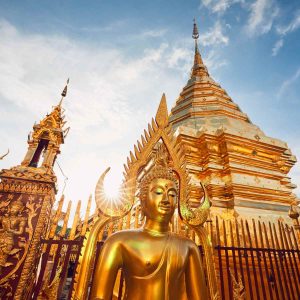
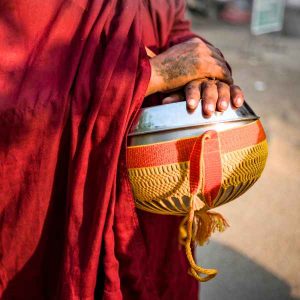
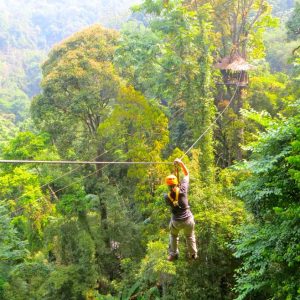
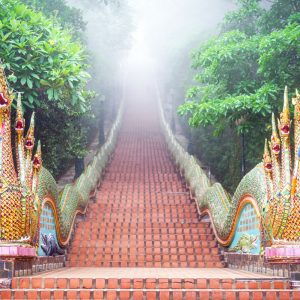
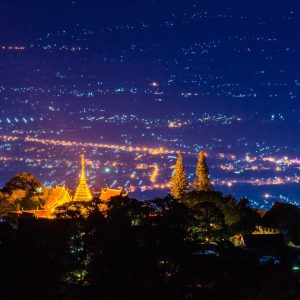
![Alternative view of Doi Suthep temple night tour - Chiang Mai [Wat Pha Lad and the Wat Phra That]](https://mythailandtours.com/wp-content/uploads/2017/11/Doi-Suthep-temple-night-tour-7-300x300.jpg)
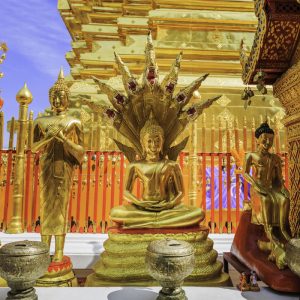
![Alternative view of Doi Suthep Puping Palace tour from Chiang Mai [$19 all included - top travelers choice]](https://mythailandtours.com/wp-content/uploads/2017/04/Half-day-Doi-Suthep-tour-Chiang-Mai-5-300x300.jpg)
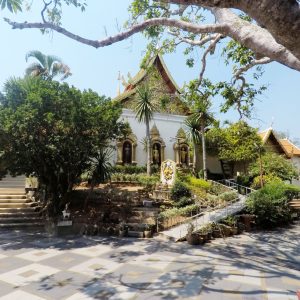
![Alternative view of Half day Doi Suthep Maew Village tour - Chiang Mai morning tour [$19 all included]](https://mythailandtours.com/wp-content/uploads/2017/04/Half-day-Doi-Suthep-tour-Chiang-Mai-7-300x300.jpg)
